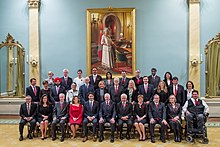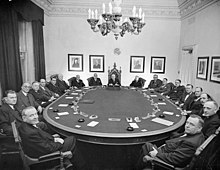Cabinet of Canada
For practical reasons, the Cabinet is informally referred to either in relation to the prime minister in charge of it or the number of ministries since Confederation.However, the Privy Council—composed mostly of former members of parliament, current and former chief justices of Canada, and other elder statesmen—rarely meets in full; as the stipulations of responsible government require that those who directly advise the monarch and governor general on how to exercise the Royal Prerogative be accountable to the elected House of Commons, the day-to-day operation of government is guided only by a sub-group of the Privy Council made up of individuals who hold seats in Parliament.But, when no party or coalition holds a majority (referred to as a hung parliament), or similar scenario, the governor general's judgment about the most suitable candidate for prime minister must be brought into play.Efforts are further made to indulge interest groups that support the incumbent government and the party's internal politics must be appeased.These individuals are assigned specific, but temporary, responsibilities on a more ad hoc basis, fulfilling tasks created and dissolved to suit short-term government priorities from within a department under a full minister of the Crown.Members of the Cabinet receive assistance from both parliamentary secretaries—who will usually answer, on behalf of a minister, questions in the House of Commons—and deputy ministers—senior civil servants assigned to each ministry in order to tender non-partisan advice.Combined with a comparatively small proportion of bills originating with individual members of Parliament, this leads to Cabinet having almost total control over the legislative agenda of the House of Commons.[33] Members of various executive agencies, heads of Crown corporations, and other officials are appointed by the Crown-in-Council; though, some of these may be made only by the Governor General-in-Council, specifically.[note 2][39] Coyne wrote in 2015: "Cabinet does not matter [...] It does not govern: that is the job of the prime minister and of the group of political staff he has around him, and of the bureaucracy beyond them."[40] John Robson criticised the use of the prime minister's name to identify the Cabinet, calling it a "bad habit" that "endorses while concealing the swollen pretension of the executive branch.These were the Ministers of Science,[43] Small Business and Tourism,[44] Sport and Persons with Disabilities,[45] Status of Women,[46] and La Francophonie.Notably Sean Fraser received a major promotion taking on the Housing file, and Pascale St-Onge took over at the Department of Canadian Heritage.




Governor GeneralDavid JohnstonElizabeth IIQueen of CanadaPrime MinisterJustin Trudeau29th Canadian MinistryRideau HallPolitics of CanadaGovernmentstructureThe CrownMonarchCharles IIIMary SimonMonarchy in the provincesLieutenant governorsExecutiveKing’s Privy CouncilList of prime ministersList of Canadian ministriesPresident of the Privy CouncilClerk of the Privy CouncilPrivy Council OfficePublic ServiceProvincial and territorial executive councilsPremiersLegislativeFederal parliamentList of parliamentsSenateSpeaker of the SenateGovernment Leader in the SenateOpposition Leader in the SenateSenate divisionsHouse of CommonsSpeaker of the houseGovernment Leader in the houseOpposition Leader in the houseHis Majesty's Loyal OppositionLeader of the OppositionShadow cabinetProvincial and territorial parliamentsJudicialSupreme courtList of justicesChief Justice of CanadaRichard WagnerConstitutionConstitution ActsPeace, order, and good governmentCharter of Rights and FreedomsElectionsFederal electoral districtsFederal electoral systemList of federal electionsProvincial electoral districtsLocal governmentMunicipal governmentForeign relationsGlobal Affairs CanadaMinisterMélanie JolyDiplomatic missions ofin CanadaNationality lawPassportVisa requirementsVisa policyCanada–Latin America relationsCanada–European Union relationsProposed annexation of Turks and Caicos IslandsCrown and Indigenous peoplesCanadian Aboriginal lawAboriginal self-governmentFirst Nations bandsIndigenous lawIndigenous Peoples in CanadaMétisInuit NunangatConservatismConstitutional lawFederalismLiberalismOffice-holdersPolitical cultureProvinces and territoriesRegionsRepublicanismFrenchministers of the CrownCanadian monarchWestminster systemgovernment of CanadaCabinetKing's Privy Council for CanadaMinistryConfederation29th MinistryHis Majesty's Governmentthe constitutionthe Kinghis Privy Councilchief justices of Canadaresponsible governmentadviseRoyal PrerogativeLester B. Pearson19th Canadian Ministryconstitutional monarchyconstitutional crisisconfidencepolitical partyhung parliamentJohn A. Macdonaldcabinet makerprovincevisible minoritywith disabilityIndigenousmembers of ParliamentsenatorridingsWilliam Lyon Mackenzie KingWestminster-derived governmentsUnited States Cabinet